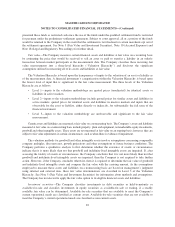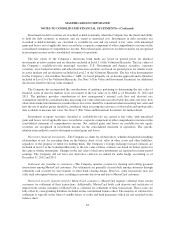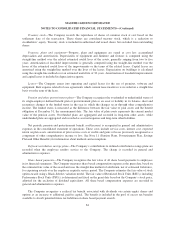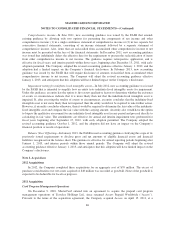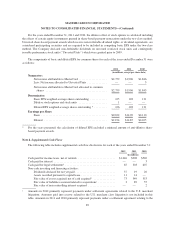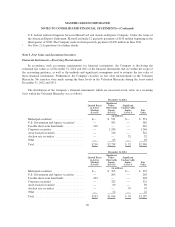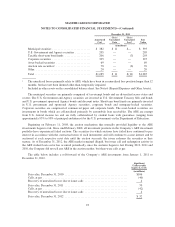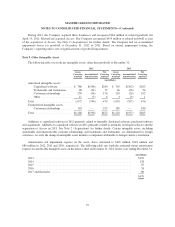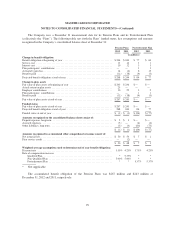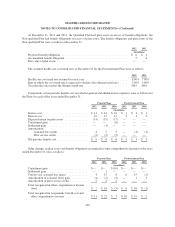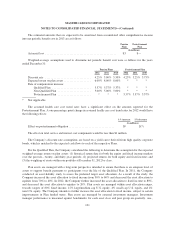MasterCard 2012 Annual Report Download - page 95
Download and view the complete annual report
Please find page 95 of the 2012 MasterCard annual report below. You can navigate through the pages in the report by either clicking on the pages listed below, or by using the keyword search tool below to find specific information within the annual report.
MASTERCARD INCORPORATED
NOTES TO CONSOLIDATED FINANCIAL STATEMENTS—(Continued)
1Available-for-sale municipal securities are carried at fair value and are included in the above tables.
However, a held-to-maturity municipal bond is carried at amortized cost and excluded from the above
tables.
2Excludes amounts held in escrow to fund the litigation settlement of $726 million which would be included
in Levels 1 and 2 of the Valuation Hierarchy. See Note 10 (Accrued Expenses) for further details.
The fair value of the Company’s short-term bond funds are based on quoted prices for identical investments
in active markets and are therefore included in Level 1 of the Valuation Hierarchy.
The fair value of the Company’s available-for-sale municipal securities, U.S. Government and Agency
securities, corporate securities, asset-backed securities and fixed income securities included in the Other category
are based on quoted prices for similar assets in active markets and are therefore included in Level 2 of the
Valuation Hierarchy. The Company’s foreign currency derivative contracts have also been classified within
Level 2 in the Other category of the Valuation Hierarchy, as the fair value is based on broker quotes for the same
or similar derivative instruments. See Note 20 (Foreign Exchange Risk Management) for further details.
The Company’s auction rate securities (“ARS”) investments have been classified within Level 3 of the
Valuation Hierarchy as their valuation requires substantial judgment and estimation of factors that are not
currently observable in the market due to the lack of trading in the securities. This valuation may be revised in
future periods as market conditions evolve. The Company has considered the lack of liquidity in the ARS market
and the lack of comparable, orderly transactions when estimating the fair value of its ARS portfolio. Therefore,
the Company used the income approach, which included a discounted cash flow analysis of the estimated future
cash flows adjusted by a risk premium for the ARS portfolio, to estimate the fair value of its ARS portfolio. The
Company estimated the fair value of its ARS portfolio to be a 10% discount to the par value as of December 31,
2012 and 2011. The Company did not realize any material losses on its ARS portfolio during the year ended
December 31, 2012. When a determination is made to classify a financial instrument within Level 3, the
determination is based upon the significance of the unobservable parameters to the overall fair value
measurement. However, the fair value determination for Level 3 financial instruments may include observable
components.
Financial Instruments—Non-Recurring Measurements
Certain financial instruments are carried on the consolidated balance sheet at cost, which approximates fair
value due to their short-term, highly liquid nature. These instruments include cash and cash equivalents,
restricted cash, accounts receivable, settlement due from customers, restricted security deposits held for
customers, prepaid expenses, accounts payable, settlement due to customers and accrued expenses. In addition,
nonmarketable equity investments are measured at fair value on a nonrecurring basis for purposes of initial
recognition and impairment testing.
Settlement and Other Guarantee Liabilities
The Company estimates the fair value of its settlement and other guarantees using the market pricing
approach which applies market assumptions for relevant though not directly comparable undertakings, as the
latter are not observable in the market given the proprietary nature of such guarantees. At December 31, 2012
and 2011, the carrying value and fair value of settlement and other guarantee liabilities were not material.
Settlement and other guarantee liabilities are classified as Level 3 of the fair value hierarchy as their valuation
requires substantial judgment and estimation of factors that are not currently observable in the market. For
additional information regarding the Company’s settlement and other guarantee liabilities, see Note 19
(Settlement and Other Risk Management).
91



